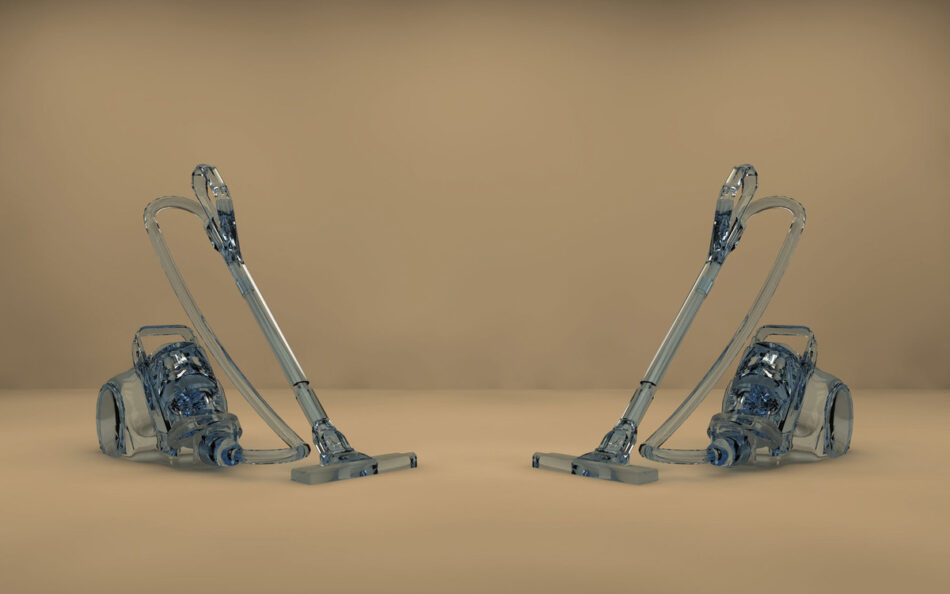FAMILI: Proxy Paranoia or Technological Camaraderie
“Will it replace me?”
The question is posed innocently, yet the stakes are clear. The context of the query is home automation (#it) and its potential “side effects” on members of the nuclear family (#me).
Already in 1966, home economist Ruth Sutherland raised this question and other concerns about the development of ECHO IV (Electronic Computer Home Operator), an ur-version of what we might today call a smart object. ECHO IV, which was born in her and her husband Jim’s basement as a bricolage of obsolete computer parts, soon grew into a sophisticated machine. In years to come, using meticulous flowcharts translated into computer-coded language, they would program ECHO IV to administer basic domestic tasks such as budget tabulations and accounting. The machine’s early capacities were perhaps modest, but the couple’s speculations on its future potential were not: temperature regulation, nutritional value intakes, parental control, educational programs for children—back then, all these computer functions still seemed like fiction. Today, they are standard offerings from the tech industry.
As for the question, Ruth was swift to realize that her chunky piece of machinery raised fundamental issues for the family and technology. To an extent, her concern seems to have anticipated many contemporary debates around smart technologies and their pervasiveness within the domestic sphere—an angst that has been reformulated time and again over the last few decades. One need only look at how this anxiety has manifested as a daunting cinematic subject, where the smart house goes from best friend to threat (Disney Channel’s Smart House, 1999), where the mechanized girl-next-door becomes a manipulative assassin (Ex Machina, 2015), and where the family robot takes the human family hostage (BBC Channel 4’s Humans, 2015). Liberation, enslavement, emancipation, alienation—the confrontational relation between #it (technology) and #me (the individual) persists. Yet, it is only by acknowledging their interwoven histories can we start to think about potential households of the future.
ECHO IV marked the beginning of the digitization of domestic labor and its associated relations. It was a prototype of the contemporary project of smartness that now systemically applies itself to cities, buildings, and objects, so much so that we almost forget its bodily roots. Before cunning, elegance, or efficiency, “smart” was originally used to describe an object that caused a sharp pain to the body. There is an inherent violence in the cunning and elegant efficiency of modern smartness, and this smart violence is always said to be positively violent for the body, to augment the body. Examples abound: the corset or the waist trainer helps and forces the body into measurements that denote beauty and taste. It is a gendered technology that normalizes and regularizes deviant bodies, giving them value. The waist trainer literally molds or smarts the body into a specific form—a true biopolitical technique. Similarly, the corridor, familial love, private ownership, domestic appliances, the mortgage, the garage, and so forth are domestic technologies that have participated in making subjects fit for the specific behaviors and tasks demanded by capitalist modes of production. They have been adapting subjects to the permanently recomposing organization of production. In this sense, the smart home must be framed in continuity with a rich history of architectural techniques devoted to the production of subjectivities. So, when Sutherland asks if these technologies will replace her, she senses that her self-as-housewife is under threat; she wonders what type of subjectivity awaits her.
To discuss the implications of the smart home for the family, one has to start by acknowledging that the nuclear family and the house-home have been historically co-constitutive. Reflecting on their correlation, the norms that define the subjects of the family can most often be traced to specific domestic inventions developed to optimize the family as a productive entity. One such invention is the modern kitchen, notoriously promoted as an instrument for the liberation of the housewife from housework. The story is well known: effectively, the kitchen allowed the housewife to manage domestic work without assistance, and it was instrumental in the diffusion of bourgeois domesticity beyond the wealthy bourgeoisie who could afford domestic workers. The modern kitchen is partly responsible for the fading of the bourgeoisie-proletariat dualism—it was part of an engine that produced a working class with bourgeois aspirations and patterns of consumption, a middle class. If this invention allowed many families to have access to some goods and (sort of) opened up wage labor to women, it also spread the rigidity of bourgeois gender identities throughout society. Further, it isolated the wife from collective spaces and practices that domestic work previously entailed, like the communal washhouse or intergenerational childcare. The paradigmatically modern revolution brought in by this “machine for living” is an important precedent to the politics that seek to liberate through mechanization. By the way, liberation from what? On this question, Endnotes journal recently said it best: “Even if the nourishing, washing of clothes, and so on, can be done more efficiently, the time for childcare is never reduced. You cannot look after children more quickly: they have to be attended to 24 hours a day.”
A similar tension resides in “smart home” rhetoric. Google’s Nest, Revolv, and Samsung’s SmartThings, among other devices and software, claim to radically expand the modernist domestic project by turning the house into an intelligent machine, intricately wired and integrated with communication facilities that will free family members from routine domestic work. And yet, one is left to wonder whose time is being saved, where it is being directed, and to what end. Yes: Nest Cams are designed to watch out for your family when you can’t; Nest’s Auto-Away function manages your energy usage while you’re rushing out the door; Echo (not Ruth’s ECHO, but Amazon’s) can help you with your shopping and to-do lists. But are smart technologies going to give you more time to cuddle your dog, or are they really just optimizing your availability on TaskRabbit?
Meanwhile, what is actually taking place is an unre-lenting erosion of what had been one of the fundamental aspects of modern politics: privacy, that 18th-century notion essential to the composition of the private individual and his or her private property. Think of how the corridor was instrumental in the making of the modern city. The corridor produced a city of rooms with a single doorway that regularized the intrusion of the other, and where one couldn’t help but compose him or herself as an individual. If domestic technologies such as the corridor and the kitchen have always been interfaces involved in the production of publicness and privacy, today, through the multiplication of Wi-Fi-enabled devices—from thermostats to washing machines, lightbulbs to cutlery, each with its own firmware and capacity to exchange data—the architectural membranes that used to mediate this boundary (walls, windows, and doors) have radically changed in their meanings.
In broad terms, two types of subjects bear the effects of this disruption. On the one hand, there’s the young, post-Fordist, ultra-connected entrepreneurial individual. Here, smart domestic appliances are yet more gadgets augmenting the self, linking to other apps, devices, profiles, platforms. On the other hand, there’s the main object of all this smartness: the pristine, archetypal nuclear family—the loving, heterosexual, married couple successfully raising two happy kids in the house they own. Here, smartness speaks to the traditional middle class, whose familiar existence is assaulted by the neoliberal condition (job insecurity, bad credit but full mortgage), threatened by social insecurities (the “poor,” the “homeless,” the “unemployed,” the “foreigner”) and the evils of the Internet. Technology presents itself as a remedy to the grave ills of the mid-20th-century family, the one now forced to rent, who divorces, whose kids love guns and porn, and who is still unable to blame capitalism. Obviously, the total control offered by smartness will not save this family, but its dramatizing rhetoric thrives on generalized paranoia and a perpetual state of exception. It exploits the real violence that the nuclear family experiences under neoliberalism. We could even argue that it reinforces the narrative of the perfect home under siege in order to induce family members to open their intimate relations to digital mediation, so that they can be measured, surveyed, and made valuable in the new data economy. The very fortress of the nuclear family built for the expansion of industrial capital must now be mined: it is a deposit of uncoded information that can only spew money when properly tapped and processed.
The development of this large-scale enterprise has required its own dedicated data-mining tools and machines, and the smartphone—a single body’s computer—remains the primordial device for the scaling of this smartness. This cyborg augmentation makes sound, sight, location, and thoughts available for datafication by channeling the interactions between bodies through devices and applications. User profiles and passwords authenticate information and actions that govern the myriad exchanges one has within the greater network. In the domestic realm, smart home products allow for smart biopolitics, recording the production of bodily information in a format suited to the control mechanisms of the network. In an age when so much value is derived from information, immaterial labor, and the surveying of everything and everyone, it is not surprising that new biopolitical technology aims to digitize as much of life as possible. This general measuring and quantification of the world is reminiscent of early cartographical endeavors and urban surveys, the crucial difference being that the information gathered is now made eminently profitable. While Google is expanding its reach beyond the mere mapping of territory to mapping interiors so that bodies and things are tracked in real time on one single map, smart wearables are becoming dangerously close to life itself: they monitor the activity, hygiene, and health of your profiled body in order to adjust its immediate market value by computing your reputation, friends, and likes as the stock options of your body-as-corporation.
The fate of the family in the midst of the smart project is unclear. We could claim that the family is becoming a sort of free association of individuals whose bind isn’t prescribed by a dubious idea of nature, with its genders and bloodlines, as was the case in the stereotypical modern family. The elemental community of modernity has in many ways lost its instrumentally naturalized purpose of reproducing the working class, relieving the family of its former defining attributes—heterosexuality, marriage, and children. Furthermore, the futurity that industrial capitalism conferred on the modern family and its children was intrinsically linked to its insatiable need for labor power. Now that the abundance and specificity of data is what generates value, blood relation and marital love appear to offer less futurity than the individual’s potential for securing affective relationships with other individuals: capital has taken over affect and sociality to the point that the most valuable good is no longer a young worker, but rather information—wherever it might come from. In Alexander R. Galloway’s words, “biomass [i.e life], not social relations, is today’s site of exploitation.”

This crisis of traditional familial futurity can be located within a larger crisis of futurity under neoliberalism and the financialization of capital. Contemporary forms of “immaterial” production, the debt economy, and the digitization of individuals and their environment have a point in common: they all require life to be turned into data to then be arranged by computerized protocols. Profiles and platforms keep track of the human capital of individual bodies, facilitating, for instance, their creditworthiness or locatability. Debt collapses modern futurity on itself through inhuman statistical predictions and estimates. The more measurements, the more information, and the faster purposes, positions, opinions, and meanings are multiplied and shuffled. Financial capital thrives on data, on pure information, and ignores actual lived realities. The notion of project cannot survive neoliberal governance and its ultra-rapid calculations toward the most immediate profit. The redefinition of power through this shift of knowledge obliterates the classical modern model based on the formulation of a project at the temporal scale of a human life. The integration of smartness throughout the city is the familiar tip of this shift from projection to codification. This might be why the family shatters as the slowness of its traditional reproductive project has become invisible to financial capital: unlike industrial capital that has to administer its workforce, algorithmic computation may be saying that there is a lot of quick money to be made by dismembering the family, even if the remaining subjects—the primary producers of information—decrease in number.
There is a widening gap between the reality of the domestic experience and the resistant image of the archetypal home found on real estate websites, Ikea, or Airbnb. This image resists because we do not know how to think of ourselves without belonging to a modern family, and because new homes are still built according to the modern family model. Nevertheless, these same architectural spaces have hosted other possibilities—to work, to be queer, to be a roommate, to have smart family relations. Typical domestic architectures, the activities/relationships in domestic spaces, and the domestic feeling of home have become very much autonomous from one another. Architecture no longer constructs domesticity the way it used to. The set of bodily relations constructed by the arrangement of rooms, walls, and doors of a house is being upset by the displacement of familial sociality over to the digital platforms of neoliberalism. The family, formed in dialectical opposition to publicness and production, now finds itself relating in the same digital language and network as the military and corporations. Because the digital realm and its platformed administration are centralizing all relationships between bodies and things in the world, the productive separation of spheres that structured the modern city are becoming obsolete; the modern city itself has a completely new topology.
The image of a city of ubiquitous production is reminiscent of Archizoom’s No-Stop City. However, considering the ways in which value is produced today, this condition will not take the architectural form of an open-plan office. And it won’t necessarily take an architectural form in the traditional, typological, sense. The translation into data of all-that-is—whether bodies, masses of bodies, objects, spaces, emotions, history, future, styles, and so forth—renders architecture instrumental as a vector of information that must be quantitatively mapped and rendered profitable to commercial operators by means of qualitative evaluation. This process takes the form of a feedback loop where the extraction of data becomes a source of pattern finding, which in turn feeds back into defining where, why, and most importantly how we live. In this context, where data is the brick and mortar of contemporary knowledge, it is by very definition impossible to make predictions on what the future family or home might end up looking like. We only know that it will not be immaterial and that increasingly, space-data correlations will be the new frontier of data-driven economies. Meanwhile, while algorithms draw our life patterns out of our likes and our memes, we, like the Addams Family, gladly feast upon those who would subdue us.
References in a random order: Jeremy Bentham, Michel Foucault, Michel Feher, Éric Alliez, Robin Evans, Alexander R. Galloway, Eugene Thacker, Evan Calder Williams, Alberto Toscano, Paul Virilio, the mule emoji, Grégoire Chamayou, Archizoom, Ru Paul’s Drag Race, Endnotes, Silvia Federici, Kim Kardashian’s Selfish, Simon Denny, G-A-Y Late, Maurizio Lazzarato, Airbnb, Amazon, Facebook, Instagram, Google, #me, Apple, and our beloved mothers.
ÅYR is an art collective based in London founded in 2014 by Fabrizio Ballabio, Alessandro Bava, Luis Ortega Govela, and Octave Perrault. ÅYR’s work focuses on the relationship between interiors, domesticity, the Internet, and the city. Recent and upcoming exhibitions include “Everything that is Solid Melts into Airbnb” at the Swiss Institute, New York; “Schöner Wohnen” at Armada, Milan; and “Comfort Zone” at Frieze Projects, London.



